GOA
History

History
Popular destinations INDIA
| Goa |
History
First inhabitants
Goa was probably already mentioned on a Sumerian clay tablet from about 2200 BC. and was then called Gubio. The North African Phoenicians had been maintaining trade relations with Goa since 1700 BC. They also brought with them an early form of Hinduism.
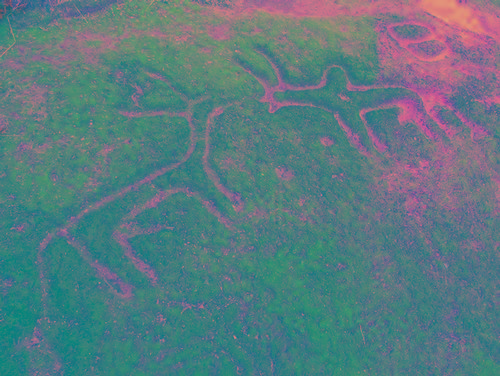 Rock drawings Goa 800 BCPhoto: Nijgoykar CC 3.0 Unported no changes made
Rock drawings Goa 800 BCPhoto: Nijgoykar CC 3.0 Unported no changes made
Historians are still unsure where the first inhabitants of present-day Goa came from. Some say they were migrants from Africa, others claim they were from East Asia. More likely, the original inhabitants came from Northern India. About 1500 BC. the Dravidians who inhabited the Ganges plain fled towards Goa and settled as semi-nomads in the Western Ghats. The language they spoke was derived from Sanskrit, Konkani.
Goa becomes an international trading center
During the Mauryan Empire (321-184 BC), Goa was part of the Kunala administrative region. Buddhism also arrived on the west coast at that time, but continued to move in the margins. After the Mauryans, Goa was ruled by the Marathis who lived about 50 BC. they where succeeded by the powerful Anand-Chuttus. This empire survived for about 100 years, and Goa then became part of the Satvahana empire.
Goa quickly developed into an international trading center that maintained trade contacts with peoples from Africa, the Middle East and even the Romans. The next rulers of Goa were the Bhojas who stayed for nearly 300 years from Chandrapur (now Chandor). Trade flourished again. Towards the end of this period, Goa became a plaything of small states in the region including the Kadambas that would later take an important place in Goan history. In the late 6th century, the entire region came under the rule of the Chalukyas from Badami. Despite the transfer of power, Kadambas were allowed to continue to govern Goa as a sort of feudal state within the region.
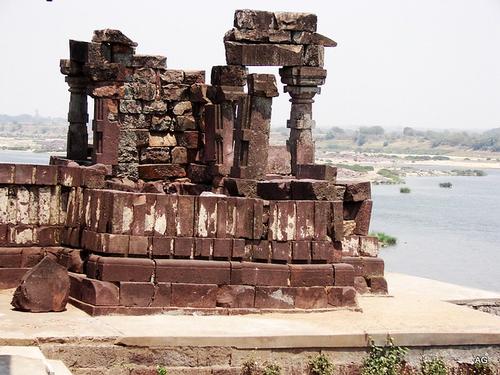 Ruins of ChandrapurPhoto: Ashish Gautam (CC BY 2.0) no changes made
Ruins of ChandrapurPhoto: Ashish Gautam (CC BY 2.0) no changes made
In the mid-8th century, the Chalukyas were defeated by the Shilaharas who would remain in power until 973 despite much internal turmoil. In that year the Shilaharas were attacked again by their old enemy, the Chalukyas. The Kadambas took advantage of this battle and conquered the capital Chandrapur in 979 under the leadership of Shastadeva. The Chalukyas condoned this action of the Kadambas and the most glorious period in Goan history started. The Kadambas ruled Goa until the early 14th century. Chandrapur grew into a large and beautiful city and would remain the capital of Goa until the year 1050. In that year, the new port city of Govepuri (now: Goa Velha) was appointed capital. Goa once again became an important trading center and underwent cultural influences from many peoples from Malabar, Bengal, Sumatra and Arab countries. It was also a period of religious tolerance where Hindus and Muslims lived side by side and with one another.
From the beginning of the 14th century, invasions of Muslims followed from the north and in 1312 the capital Govepuri was destroyed, fifteen years later Chandrapur followed. In 1352, Goa finally came under the rule of the Bahamians. They held Goa for about 25 years and were then chased away by the soldiers of the Vijayanagar empire. Many Hindus had already fled from Goa. In the period that followed, the thread was picked up again and trade with the Arabs was resumed. At the beginning of the 15th century, the Bahmanis tried to recapture Goa. Three attempts failed, but the fourth attempt in 1471 was successful and Goa became part of the Bahmani kingdom again. Again Govepuri and many Hindu temples were destroyed. Within twenty years, however, the Bahmani Empire was divided into four groups by mutual disputes. The Bahmanis still built a new capital near the Mandovi River called Gove.
Portuguese rule
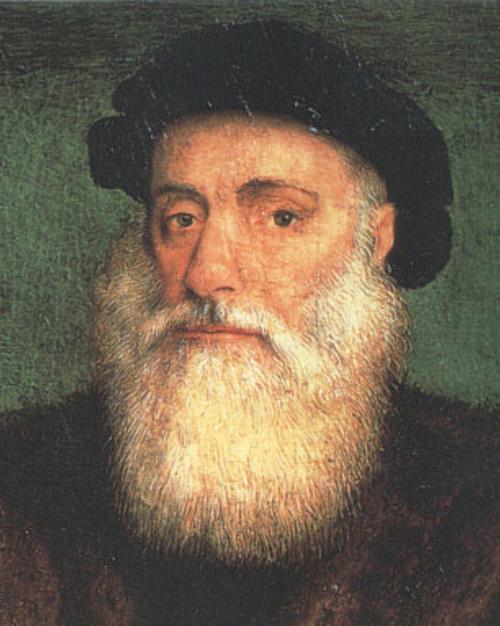 Vasco da Gama, GoaPhoto: Public domain
Vasco da Gama, GoaPhoto: Public domain
In 1498, the Portuguese explorer Vasco da Gama landed south of Goa near Calicut (now: Kozhikode) on the Malabar coast. The Portuguese, at the height of their power as a seafaring empire, tried to control the spice routes. One of the conditions for achieving this was a permanent base on the Indian coast. They managed to build a small fort in Cochin (now: Kochi) in Kerala.
In 1503 the nobleman Afonso de Albuquerque sailed to Cochin to strengthen the base. In 1508 he traveled to India again, among other things because it was rumored that the Arab occupiers of other coastal states were ready to attack the Portuguese fleet. In March 1510 Afonso conquered one of the most important islands in the river. The current capital Panaji was to be built here. Two months later, Afonso was expelled again but in November he recaptured Gove. As a punishment, all Muslim occupiers were killed. Afonso left four months later and the Arabs tried to regain possession of the city. Afonso returned in time and defeated the Muslims in 1512. Under the leadership of Afonso, the Portuguese managed to more or less keep friendships with surrounding enemy empires and also let play them off against each other. In 1515 Afonso died on board a ship in the port of Goa. Although the Portuguese had repelled the first threatening situation, their position was not very flourishing because they were surrounded by their enemies. The Portuguese were not bothered when they were offered some land by the Hindus. They received this offer because of some successes against the Muslims. The Portuguese quickly occupied some areas but could only keep them for a few years. Threatened Muslim attacks led to the withdrawal of the Portuguese. The Portuguese then deployed their joker, Mir Ali. This Muslim was a threat to the ruling Muslims and a compromise was quickly made. Mir Ali was expelled from the region and Portugal finally took possession of the Bardez and Salcete areas. Together with Tiswadi, these were the three areas that would be under Portuguese rule for the next 250 years and would be known as "Old Conquest" or "Velhas Conquistas".
Trade flourished again and practically all merchandise was traded through the Goan ports. In addition, all skippers had to pay taxes for the protection that the Portuguese provided at sea. In 1565, the unified Muslims defeated the army of Vijayanagar, and in 1570 the Portuguese were also attacked. After a ten-month siege, the Muslims withdrew. Meanwhile, the Christianization of the population started quietly, but in 1541 this changed radically. After the arrival of some fanatical zealots, a law was passed stipulating that all Hindu temples should be destroyed. Other religious expressions were also suppressed and this inquisition would last nearly 200 years and become a black page in Goa's history. Nevertheless, the Roman Catholic missionaries also did a good job of establishing schools and hospitals and introducing new farming methods.
Portugal under attack
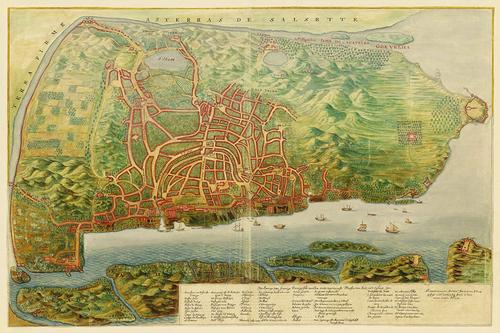 Map Goa 1665Photo:Public domain
Map Goa 1665Photo:Public domain
Late 16th century and the entire 17th century would be a difficult period for the Portuguese. They were threatened and attacked from all sides. First of all, they were annexed in Europe by the Spaniards themselves and only became independent again in 1640. Even more important was the emergence of the English and the Dutch as competing naval powers. For example, the Portuguese fleet was defeated in 1612 by ships of the British East India Company. The Portuguese tried to limit the loss by allowing the British to trade freely in all Portuguese ports in this part of Asia. All this was enshrined in the Goa Convention in 1635. The Dutch were not unrepentant either. They attacked Goa in 1637, conquered Malacca, besieged Cochin in 1657, and soon dominated the trade routes to the east. In the second half of the 17th century, Goa was severely threatened by the Marathas. In 1683, the Marathas were about to capture Goa when they were attacked in the back by a Mughal Indian army. In 1737, the Marathas returned and conquered several Goan areas.
The threat of losing everything prompted the Portuguese to start peace negotiations. It was agreed that the Marathas would receive the area around Bassein near Mumbai in exchange for withdrawing from Goa. In 1762, Sonda's Raja asked the Portuguese to protect his belongings from his enemy Hyder Ali of Mysore. The Portuguese took this very literally and permanently occupied the areas of Ponda, Sanguem, Quepem and Canacona. Between 1782 and 1788, Pernem, Bicholim, and Satari were also added to the colony, thereby the Portuguese controled Goa's current territory. The differences within the colony were very large as the Inquisition came to an end and religious orders were suppressed. As a result, the new areas were no longer forced to be Christianized. During this period, Old Goa, from a prosperous city with 200,000 inhabitants, became almost a ghost town due to a number of infectious diseases. The board also left the city and settled in Panaji, which officially became the capital of Goa in 1843.
In 1787 a rebellion was planned by Goan church leaders. However, the conspiracy was discovered and the leaders were either killed or captured. In the late eighteenth century (1797), Goa was occupied without firing a shot by the British, who at the time were engaged in battles with a southern monarch who had allied himself with the French. Despite Portuguese protests, a British garrison remained in Goa until 1813. In 1839, the British government made a bid of £ 500,000 to Goa. The Portuguese did not respond to this, afraid of losing face.
Striving for independence rears its head
The nineteenth century was characterized by constantly reviving independence movements from the Ranes clan, among others, who initiated various uprisings. For fifty years it was restless in Goa until the Portuguese were suppressed by military force in 1912, after 14 rebellions, after 14 rebellions. In 1910, when the Portuguese monarchy disappeared, Goan's right to self-determination seemed only a matter of time. However, at the last minute, this was canceled and this led to a strengthening of the Goan Independence Movement, which was also inspired by the struggle for independence in British India.
On June 18, 1946, a prominent activist, Dr. Ram Manohar Lohia, was arrested during a demonstration. Large-scale demonstrations followed and some 1,500 people were imprisoned. These actions kept the people of Goa quiet for a while, although radical attacks on police stations were carried out by a militant wing of the Independence movement, the Azad Gomank Dal. On June 10, 1947, Teofilo Duarte, the Portuguese Colonial Minister, warned that the Portuguese would not withdraw from Goa without bloodshed. The government of independent India since 1950 also made some proposals regarding Goa, but the Portuguese made it clear that there was nothing to talk about. Diplomatic relations between India and Portugal were even broken on June 11, 1953.
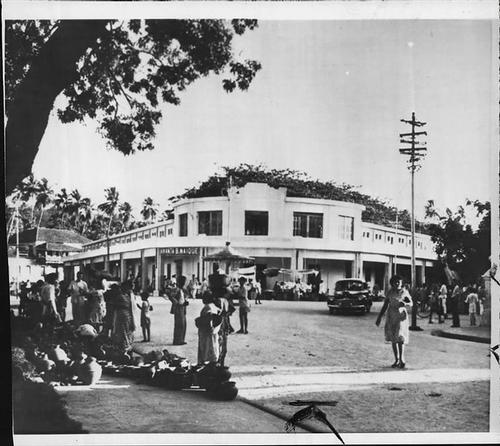 Goa 1954Photo: Goenchi Mathi (CC BY 2.0) no changes made
Goa 1954Photo: Goenchi Mathi (CC BY 2.0) no changes made
On August 15, 1954, a large nonviolent demonstration (satyagraha) was organized by the nonviolent group of the National Congress Goa. However, many were arrested and taken prisoner. A year later another large demonstration was held, this time by Indians outside Goa. This peaceful demonstration was violently answered by the Portuguese. Several protesters were killed and hundreds injured, resulting in a renewed violent crackdown by the Azad Gomank Dal. Many political and economic attacks were carried out. During this period, India put pressure on the international community (including the United Nations). However, this still did not lead to any concessions from the Portuguese. India's Prime Minister Jawaharlal Nehru has yet refused to forcibly take Goa from the Portuguese, advocating nonviolent actions.
Then the Maharashtra state government announced its intention to violently take over Goa from the Portuguese. Despite protests by Nehru, Indian troops invaded Goa on the night of December 17-18, 1961, and by December 19, most Portuguese had already disappeared. After the liberation of the Portuguese, Major General Candeth was appointed Governor of Goa.
Goa officially part of India
Under the terms of the Constitution 12th Amendment Act of 1962, the former Portuguese colonies of Goa, Daman and Diu were integrated as a Union territory in the Indian Union. Several elections were held towards the end of 1962 to launch the new political system. At the end of December 1962, the first government of Goa started its work.
The only problem was Goa's position vis-à-vis the Indian Union. Neighboring State of Maharashtra insisted that the Goan territory be added to that of Maharashtra and that the language of Goa, the Konkani, should not be recognized as an official language. This problem was solved on January 16, 1967 after a poll conducted by the Goan people that the population wanted to become an official state of India. In May 1987, Goa split from Daman and Diu, officially becoming the 25th state of the Indian Union. The language of Goa, the Konkani, became one of the official languages of India in 1993. The 1990s were characterized by an unstable political situation and disruption of daily life throughout India, including in Goa. The so-called “floor crossing” (ministers who constantly switch political parties) caused a lot of unrest.
See also the history of India on TheWorldOfInfo.
Sources
Olden, M. / Goa : Hampi, Bombay en Poona
Elmar
Thomas, B. / Goa
Lonely Planet
CIA - World Factbook
BBC - Country Profiles
Copyright: Team The World of Info